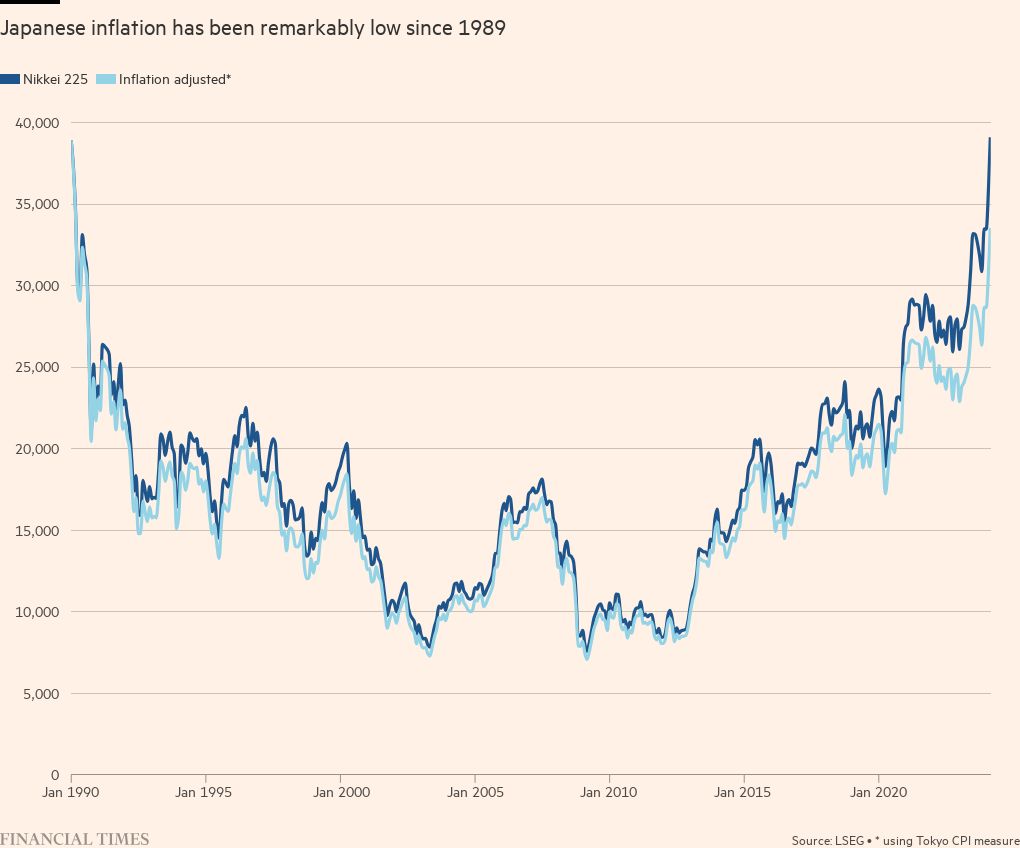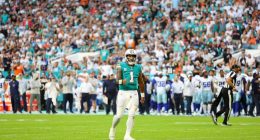In late 1989, when the Japanese stock market hit its previous record high, the country was in the grip of one of the biggest asset price bubbles in history and its newly minted millionaires were buying trophy assets around the world.
But this week, as the Nikkei 225 finally broke through that peak after a 34-year wait, investors said that a lack of such exuberance is a sign that the market could have much further to climb.
“It is completely different from the bubble era,” said Seiji Nakata, president of Daiwa Securities. “The stock level [this time] was achieved on calm rationale and without any feeling of overheating.”
Within minutes of the record falling on Thursday, traders in Nomura’s Tokyo dealing room erupted into a standing ovation. The brokerage’s chief executive, Kentaro Okuda, joined them on the floor and called a press conference to reassure the listening world that, even at these heights, Japan was still a “buy”.
Many share this view. The market’s decades-long recovery has been helped by years of “Abenomics” reforms under former prime minister Shinzo Abe, direct support from the Bank of Japan’s purchases of exchange traded funds and a protracted campaign to improve corporate governance, and does not bear the hallmarks of the late 1980s bubble, say analysts.
Masashi Akutsu, chief Japan equity strategist at Bank of America, on Monday raised his year-end forecasts to 41,000 for the Nikkei and 2,850 for the Topix, compared with 39,098.68 and 2,660.71, respectively, on Thursday. The 40,000 level in the Nikkei is “just a passing point”, he said.
Further buying by foreign investors is also viewed as a potential driver for the market.
Many abandoned Japan during the long, painful bear market following the 1989 peak. From a 37.5 per cent share of total global stock market capitalisation in 1990, above even the US, Japan had fallen to just 6.3 per cent by 2022, while the US had swollen to more than 58 per cent, according to research by academics Elroy Dimson, Paul Marsh and Mike Staunton. Many felt they could afford to ignore Japan as long as China was the dominant Asian growth story.
However, a steady stream of fund managers and other investors have been making their way to Tokyo over the past 18 months to re-evaluate the market.
Now that the China investment narrative is overshadowed by domestic economic difficulties, a property crisis and a deterioration in relations with the west, Japan has become more interesting — particularly with the yen trading around the historically low level of Y150 against the dollar.
“Foreign investors . . . appreciate the improvements in corporate governance and they are more confident about Japan’s ability to overcome deflation,” said Nomura’s Okuda. “The medium- to long-term outlook [for the market] is solid,” he added, noting that while Japan had taken its time to make progress on governance and economic reforms, that progress was now locked in.
Others echo the view that the Nikkei is still far from bubble territory. A Bank of America survey this month showed the net percentage of global fund managers who were overweight Japanese stocks had risen to 13 per cent.
That is encouraging for a market where foreign investors have been a crucial driver of the recent rally. Foreigners bought a net ¥378bn of cash equities in the TSE Prime market in the first full trading week of February, TSE data shows, building on net purchases throughout January.
Nevertheless, investors are largely taking a measured approach, with many domestic retail savers still wary. That is in part due to the trauma left by the bursting of the 1989 bubble, with many Japanese still viewing the stock market as only marginally less risky than a casino.
Japanese households have resisted years of efforts to persuade them to move some of the $7.7tn of combined savings they currently hold in cash and deposits into equities.
At the start of this year the government expanded the size of the Nippon Individual Savings Account scheme for individuals, raising both the limit on annual contributions from ¥1.2mn to ¥3.6mn and the cumulative limit from ¥6mn to ¥18mn.
Early evidence suggests that Japanese have loaded their accounts with products that give exposure to either US equities or a global basket of stocks, rather than to domestic equities. However, an official at Japan’s Financial Services Agency noted that some 20 million NISA accounts have now been opened, with people in their 20s and 30s appearing to be taking their first steps into investment.
Since 1990 and the so-called lost decades that followed, there have been six big rallies, all of which ultimately fizzled out. In real terms, the Nikkei — which is unevenly weighted to a small handful of stocks and more representative of export-driven companies — is about 14 per cent away from a record high, a relatively modest gap that reflects years of low inflation or deflation in Japan.
The much broader Topix, which holds hundreds of domestically focused companies and struggling regional banks, has yet to hit its December 1989 peak of 2,884 in nominal terms, and is still about 8.5 per cent away. Nomura analysts have a December target of 3,050 points for the index, and making a new record high should be “fairly easy”, said chief Japan equity strategist Yunosuke Ikeda.
He highlighted a change in Japanese companies’ approach to buybacks: whereas in the past they would buy back shares while the market was weaker and their own share prices were low, now they are buying their own shares at record rates of ¥9.4tn last year and ¥1.5tn so far this year, despite the higher valuations.
“It is remarkable. The market is not cheap, but Japanese companies are proactively buying back shares at these levels. It is a big positive for the market,” said Ikeda.
Bruce Kirk, Japan equity strategist at Goldman Sachs, has even come up with the “Seven Samurai” — a group of Japanese stocks comparable to the “Magnificent Seven” tech stocks that have driven the US market rally. It comprises Screen Holdings, Advantest, Disco Corp, Tokyo Electron, the trading house Mitsubishi and automakers Toyota and Subaru.
But the disconnect between the Nikkei’s rally this year and the state of the economy has left some investors nervous that the market has got ahead of itself. Gross domestic product has been negative for two consecutive quarters, while inflation is falling, raising fears of a return to deflation.
“There is a sense of overheating,” said Koji Toda, a fund manager at Resona Asset Management. “At the end of the day, there is still no certainty in terms of exiting deflation.”
Also Read More: World News | Entertainment News | Celebrity News









